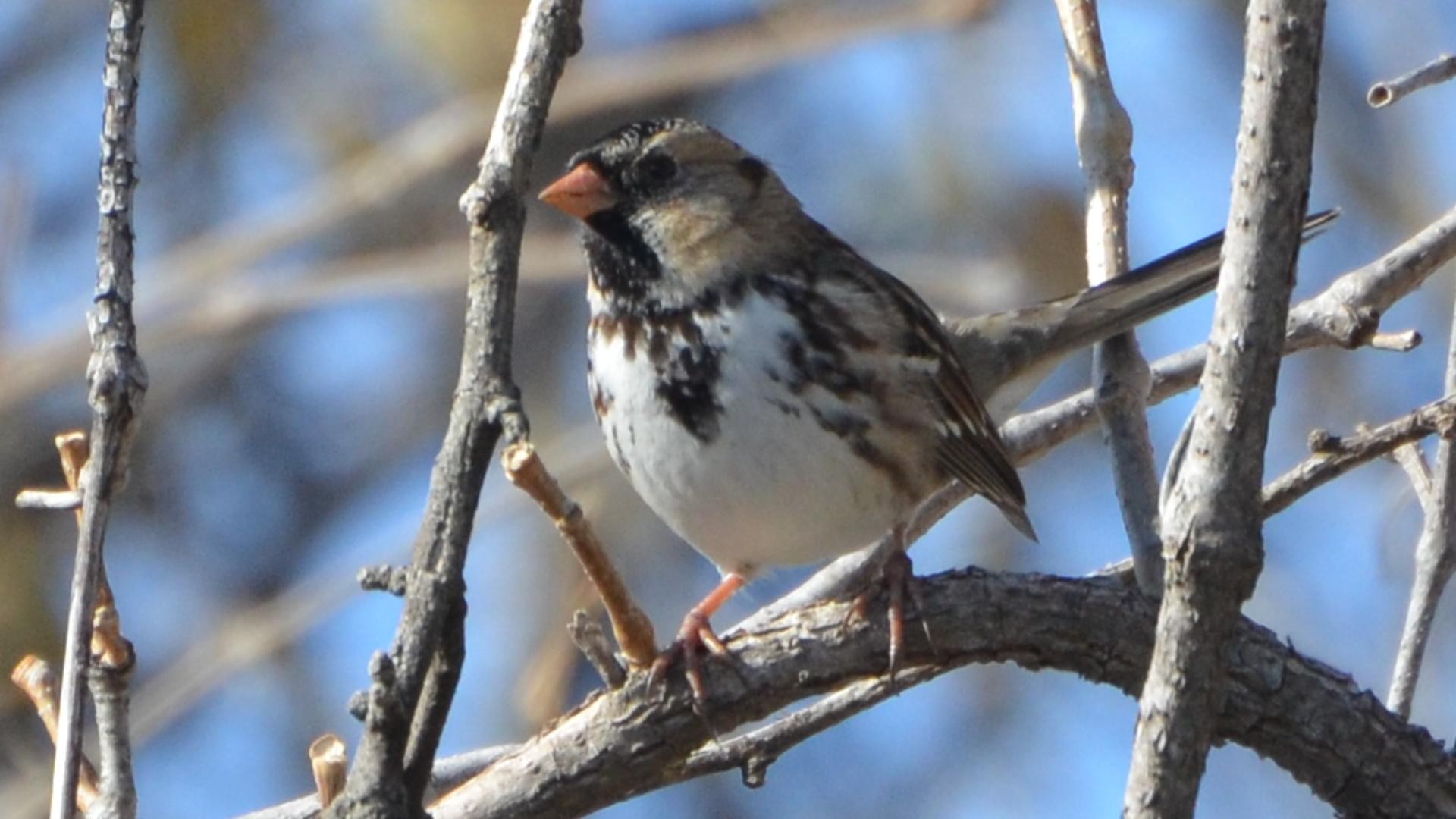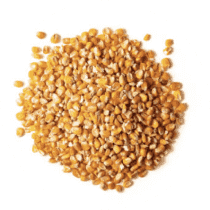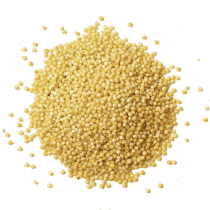Harris's Sparrow
A species of Crowned sparrows Scientific name : Zonotrichia querula Genus : Crowned sparrows
Harris's Sparrow, A species of Crowned sparrows
Botanical name: Zonotrichia querula
Genus: Crowned sparrows
 Photo By Andy Reago & Chrissy McClarren , used under CC-BY-2.0 /Cropped and compressed from original
Photo By Andy Reago & Chrissy McClarren , used under CC-BY-2.0 /Cropped and compressed from original Description
This species is the largest of the sparrows in the family Passerellidae, though other superficially dissimilar species in the family may slightly exceed them in size. They range in total length from 17 to 20 cm (6.7 to 7.9 in), with a 27 cm (11 in) wingspan and weigh from 26 to 49 g (0.92 to 1.73 oz). Among standard measurements, the wing chord is 7.7 to 9.2 cm (3.0 to 3.6 in), the tail is 7.6 to 8.8 cm (3.0 to 3.5 in), the bill is 1.1 to 1.4 cm (0.43 to 0.55 in) and the tarsus is 2.2 to 2.5 cm (0.87 to 0.98 in). This is a very distinctive looking species. Breeding plumage birds have conspicuous pink bills and black on the crown, face, throat and upper breast, contrasting with grey on the sides of the head and neck. The back is brown, overlaid with heavy black streaking. There are two white wing bars. Breeding birds have white lower underparts with some black mottling on flanks. Non-breeding adults are more buffy than grey and brown, with reduced or absent black markings and often have whitish scalloping on the head and throat. Immatures have less black than all adult plumages, normally marked with a white chin and throat, a black malar stripe and a broad smudgy black breast-band. Juveniles have a brownish crown streaked with black and fine dark streaks and some broader black markings on the underside. Birds moult from July to September. Confusion of wintering birds is possible with the winter Lapland longspur (Calcarius lapponicus) but that species is much shorter-tailed with white outer rectrices, has rich rufous in greater coverts, and is strictly terrestrial on open ground. The song of the Harris's sparrow is usually delivered from a high perch. The song consists of a series of one or more clear high wavering whistles followed by another series in higher or lower pitch. They have also been known to call out a strong, metallic chink, as well as some variable musical twittering. 
Size
17-20 cm (6.75-7.75 in)
Colors
Brown
Black
Gray
White
Life Expectancy
12 years
Nest Placement
Ground
Clutch Size
3 - 5 eggs
Number of Broods
12 - 14 days
Nestling Period
8 - 10 days
Feeding Habits
Harris's Sparrow's diet consists of seeds, fruits, and insects. They forage mainly on the ground, eating seeds from Carex sedges, grasses, and ragweed. They consume crowberries, bearberries, and Vaccinium species, with larval insects becoming important in summer. During breeding, harris's Sparrow forage alone or in pairs, with rare supplements of plant material like spruce needles and flower buds.
Habitat
Harris's Sparrow typically inhabits the forest-tundra ecotone in the breeding season, preferring stunted coniferous forests with spruce, larch, birch-willow, and wet sedge meadows. These are areas where the northern limit of tree growth intersects with shrubby tundra. In winter, harris's Sparrow migrates to open woodlands, edges, riparian thickets, and prefers suburban feeders. They avoid dense woods and dry shortgrass prairies, yet may be drawn to tallgrass prairies, marsh elder, and giant ragweed during migration.
Nest Behavior
The female harris's Sparrow meticulously assembles her nest over 2–3 days. This species exhibits a defined egg-laying pattern, and both parents are involved in nurturing the eggs and tending to the fledglings, demonstrating dedicated parental care.
Nest Characteristics
Harris's Sparrow's nest is a ground-based, cup-shaped structure commonly tucked beneath shrubs like alders, spruces, dwarf birches, or Labrador teas, sheltered from prevailing winds. It measures approximately 2.5 inches in diameter and 2 inches deep, constructed from mosses, twigs, and lichens, and lined with dried sedges and grasses.
Dite type
Granivorous
Migration Overview
Spring migration commences around late February with birds arriving on breeding grounds by May. Sparrows arrive on their wintering grounds as early as late October, though mostly during November and early December. Records from Banff National Park suggest Harris's sparrows use mountain valleys as migration routes. Apparently, fall migration is less strict than spring migration as Harris's sparrows regularly wander about prairie provinces in Canada until harsh weather forces them south. 
General Info
Feeding Habits
Bird food type

Black Oil Sunflower Seeds

Hulled Sunflower Seeds

Cracked Corn

Millet
Bird Feeder Type

Platform

Ground
Behavior
Harris's Sparrow engage in typical sparrow activities such as hopping along the ground and foraging for food while occasionally perching on low branches. They rest and sing from higher shrubs and trees, seeking shelter in foliage when threatened. After arriving at breeding grounds, harris's Sparrow quickly form monogamous pairs, with males singing to mark territories. Though these pairs are solitary when nesting, harris's Sparrow join mixed foraging flocks in winter, where a distinct hierarchy emerges based on age and throat patch darkness.
Species Status
This species is classified as being of least concern by the IUCN. The total population is estimated at 3.7 million individuals. However, the species came to be included on the "Audubon Watchlist" because there appears to have been a decline in the number of birds observed in annual Christmas Bird Counts across North America. The species is fairly adaptable in wintering habitat and feeding opportunities and its habitat is isolated enough to be out of reach for heavy human development, which makes the recent declines something of a mystery. The species breeds on the northern edge of boreal forests and it is possible that habitat change in their breeding range is affecting this sparrow. The boreal forest, beyond heavy logging, has been adversely affected by increased wildfire and declining soil quality, both of which are likely correlated to global climate change. 

 Photo By Andy Reago & Chrissy McClarren , used under CC-BY-2.0 /Cropped and compressed from original
Photo By Andy Reago & Chrissy McClarren , used under CC-BY-2.0 /Cropped and compressed from original Scientific Classification
Phylum
Chordates Class
Birds Order
Perching birds Family
New world sparrows Genus
Crowned sparrows Species
Harris's Sparrow